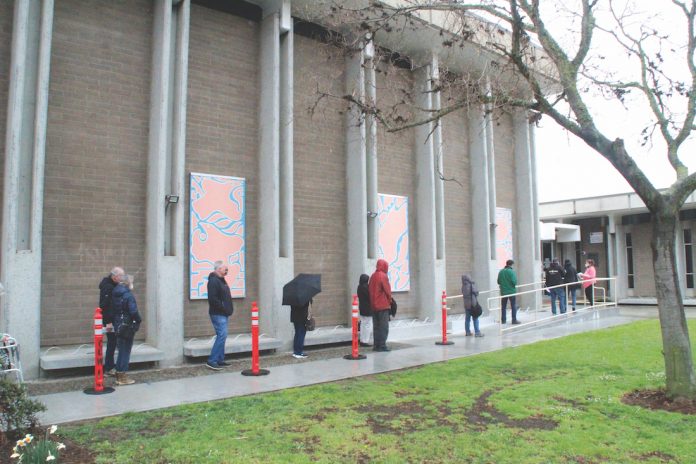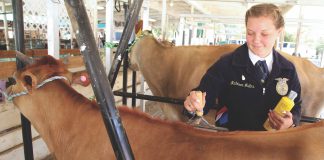SANTA CRUZ COUNTY—The Covid-19 vaccine does not alter a person’s DNA, contain a microchip or cause infertility, says Santa Cruz County Health Officer Dr. Gail Newel.
At Thursday’s virtual weekly press conference Newel debunked those myths about the vaccination and several others in hopes that it would ease the minds of some residents in the Latinx community that have been cautious to receive the shot, county spokesperson Jason Hoppin said.
“We’re hearing some anecdotal evidence of resistance, nothing major but it was a little bit curious,” Hoppin said. “So we just wanted to get some of the right information out there to people.”
Those comments came just four days after the County Health Services Agency expanded its vaccination efforts from front-line health care workers and those above the age of 65 to include workers in education and childcare, emergency services and food and agriculture industries.
County health officials say that about 70 percent of teachers in the county have received their first vaccine dose, as almost every school district gears up to return to in-person instruction over the next few weeks.
In addition, about 63 percent of the county’s residents aged 65 and above have received their first dose, and 17 percent have received both doses.
Those numbers were some of the few figures county health officials shared Thursday. Because of incomplete data entry, says County Deputy Health Officer Dr. David Ghilarducci, it is still unknown if the rate or number of Latinx residents receiving the vaccine has improved since the county released statistics earlier this month showing 7,000 residents of that ethnicity had received the shot, compared to 37,000 residents of other ethnicities.
But Ghilarducci says the efforts to reach the most impacted demographic in the county—Latinx residents make up more than half of positive Covid-19 cases despite being only a third of the population—are trending in the right direction. Chief of Public Health Jennifer Herrera says the county is also working with various nonprofits in the Watsonville area and the Santa Cruz County Farm Bureau, whose members employ thousands of Latinx residents throughout the Pajaro Valley, to bump those numbers up before the upcoming growing season.
“We’re working with them on outreach methods to ensure that we build vaccine confidence among the Pajaro Valley region, as well as farmworkers, and that we develop a structure of vaccine clinics that is accessible, which may include providing vaccines on-site in the fields,” she said.
Other than those concerns, county health officials had mostly good news to report Thursday. The rate of infection within the county has plummeted to 8.6 cases per 100,000 residents, and Newel said the county could move from the purple “widespread” tier to the red “substantial” tier as early as next week. It is more likely, however, that the move will happen in two to three weeks.
That would mean, among other things, that indoor dining could return, and middle and high schools could welcome back students for in-person instruction. Newel, however, urged residents to continue to follow the masking and social distancing orders put in place to slow the spread of novel coronavirus.
“Even if you’re vaccinated,” she said.
Vaccine eligibility for occupation-based appointments will be based on occupation definitions from the California Department of Public Health. Proof of occupation will be required. County health will start occupational vaccinations by working with eligible employers to arrange clinics. Eligible employers can begin the process by filling out a Covid-19 Vaccine Interest Survey at bit.ly/2NnFAUA.
Individuals are encouraged to sign up through myturn.ca.gov or contact their health care provider to find out when they can receive the vaccine.
The vacation pool will open further on March 15. Then, people with various health conditions that put them at higher risk for serious illness from Covid-19 can be vaccinated by their health care provider.
By then, Newel said, the hope is the county will have more vaccines than it can administer per day. She said that if the Johnson & Johnson vaccine receives approval Friday, that state officials have told her the county can expect an immediate 50 percent increase in their weekly vaccine distribution—they’re currently receiving 2,000-4,000 vaccines per week.
“That will be a happy day when that happens and we’ll see if that comes true,” she said.
Santa Cruz County on Monday ranked seventh in the state in Covid-19 vaccination per capita, with 24,282 vaccinations per 100,000 people, according to information provided by the county. The county is in second place for counties with populations over 250,000 in California.
In Santa Cruz County, 183 people have died from Covid-19 and nearly 14,000 have recovered. There have been 14,588 known Covid-19 cases in Santa Cruz County, of which 446 are known active cases, according to information last updated Thursday evening by county health officials.









